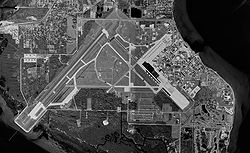MacDill Air Force Base
| MacDill Air Force Base | |
|---|---|

|
|
| Characteristics | |
| ICAO code | KMCF |
| IATA code | MCF |
| Coordinates | |
| Height above MSL | 4 m (13 ft ) |
| Transport links | |
| Street | I-275 / FL 685A |
| Basic data | |
| operator | US Air Force |
| surface | 2335 ha |
| Start-and runway | |
| 04/22 | 3481 m × 46 m asphalt |
The MacDill Air Force Base (in short: MacDill AFB) is a base of the US Air Force in Tampa , Florida . It is the headquarters of the Unified Combatant Commands US Central Command (USCENTCOM) and US Special Operations Command (USSOCOM). Active flying units at the base are part of Air Mobility Command . The base houses the Aircraft Operations Center .
history
Until World War II
During the Spanish-American War in 1898, Tampa was the starting point for troops who supported Cuba in its struggle for independence from Spain due to its strategic location .
With the beginning of the Second World War an air base was set up in the immediate vicinity, the Southeast Air Base, Tampa , which was later named after Colonel Leslie MacDill . Pilots were trained on the Boeing B-17 “Flying Fortress” and Martin B-26 “Marauder” aircraft , and the base served as a starting point for flights to Australia via the South Atlantic and Africa .
When the US Air Force was founded in 1947, the base was given its current name, MacDill AFB.
post war period
In the post-war period it continued to be used for training bomber pilots who were trained on the B-29 , B-47 , B-50 and P-51 types .
On March 10, 1956, a Boeing B-47 disappeared from the base during a non-stop overflight in the Ionian Sea after a second refueling maneuver in the Mediterranean with a tanker aircraft at an altitude of over 4,200 meters failed. The bomber had nuclear weapons on board as cargo, but no atomic bombs, and the aircraft has not yet been found.
In 1960 there were plans to close the base, but the strategic importance of this airfield grew again due to the Cuban Missile Crisis . In 1961, the US Strike Command was established at MacDill AFB with liaison officers from all branches of the armed forces to deal with global crises.
The pilot training was continued on machines of the type F-84 and later F-4 Phantom . In 1972 the US Strike Command was transformed into the US Readiness Command. In 1979 the first F-16 machines appeared in MacDill and in 1983 the Rapid Deployment Joint Task Force was activated there, the predecessor of today's United States Central Command (USCENTCOM). In 1987 the US Readiness Command was replaced by the US Special Operations Command (USSOCOM).
MacDill Air Force Base was a possible emergency landing site for the space shuttle in the event of an unscheduled landing.
today
In the early 1990s, as part of a plan to reduce troops and bases, all MacDill flight activities were moved to hatch AFB . Air operations resumed only a few years later after MacDill AFB became the location of the 6th Air Base Wing. As part of Operation Uphold Democracy in Haiti one was once again the strategic position of the base aware and so the base received new orders, especially for the operation of KC-135 -Tankflugzeugen and later by EC-135 - and CT-43 - Machinery.
Web links
- MacDill Air Force Base website (English)
Individual evidence
- ↑ DOD support to manned space operations for STS-127th US Northern Command, July 9, 2009, accessed October 7, 2011 .
